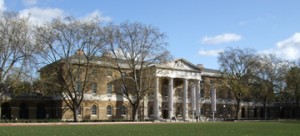
The Saatchi Gallery, 2008. Courtesy Jim Linwood, licensed under the Creative Commons Attribution 2.0 Generic license.
A short post today and a follow-up, of sorts, to my earlier post Timing is Everything. It was announced on Thursday afternoon that Charles Saatchi would be gifting a substantial amount of his collection, as well as his Chelsea-sited gallery, to the United Kingdom. The two hundred works, worth an estimated £25 million (or $37 million) and the gallery would be handed over to a foundation in the very near future and, upon Saatchi’s retirement, would then be handed over to the relevant government department (still, at this point, under discussion and yet only in terms of a “potential government department” — a fluffy comment that actually means nothing) and the Saatchi Gallery would be re-named Museum of Contemporary Art, London. A permanent collection will be maintained, as well as a rotating programme of major exhibition. Cynicism abounds, and the statement delivered to the press by the Saatchi Gallery reads as though it has been hastily assembled from a whimsical idea conceived by Saatchi over breakfast with celebrity chef wife Nigella Lawson based on what his legacy would be fifty years from now. Every press agency is running the same news, almost verbatim, and the response thus far has been one of bemusement over anything else. Generous though the offer is, the BBC’s arts editor Will Gompertz does also note that Tate Modern may have more than a strong claim to say that it already runs the nation’s contemporary art museum and have no intention of going anywhere, especially with the news that the current director of Haus der Kunst Munich, Chris Dercon, will join as director from Spring 2011 and plans for Tate Modern 2 not likely to be shelved, in favor of an extended construction timetable.
I blogged earlier on the surge of the museum of contemporary art, the trend to turn galleries into cultural institutions. In Saatchi’s defense, other than his own, there is barely a decent gallery in Chelsea (if one excludes a certain institution a couple of miles up the road, a hoary but venerable place on Millbank, next to Chelsea College of Art and Design, and which despite its location on the riverside actually has a very nondescript view over the Thames). Sure the DCMS currently may be shrugging its shoulders in stupefaction at the donation (“You say Saatchi did what?”) but, they should be assured, no charges will fall to the state. “All costs associated with the storage, restoration or cataloguing the collection will be borne by the museum,” said Associate Director of the Saatchi Gallery, Rebecca Wilson. This includes by revenue-generating methods including the restaurant, gift shop, corporate events and private sponsorship. Personally, I do not buy the long-term sustainability of this plan, but I am sure that current Culture Minister Ed Vaizey MP will be fine with it.
That, essentially, is the core of the issue. Will the government be willing take on a new museum of contemporary art when the current flag-bearer (and many more besides) is competing to become one of the most progressive and important institutions in the world, and dependent on political posturing to make sure that it happens? The Saatchi Gallery may be running very successfully at present as a private art gallery (or is it? Perhaps there is an ulterior motive to this gift; I dare ask what the tax implications are for gifts to the nation) but a national museum for contemporary art as a private enterprise? Charles Saatchi was a committed and very public New Labourite and these plans sound remarkably aligned to the designs of the new Conservative/Liberal Democrat coalition.
The other core issue is where the hole in contemporary art occurs that facilitates this kind of decision-making. The artists in support of Saatchi are enthused by the decision and vocal too, and these are no meager names: Tracey Emin, Jake and Dinos Chapman, Richard Wilson, and Grayson Perry, to name but four. Charles Saatchi has been relentless in his collection of the work, especially, of the Young British Artists and has been at the forefront of the boom years of contemporary British art, along with gallerists including Jay Jopling, Sadie Coles and Victoria Miro. Gifting his substantial collection to the nation will provide a legacy for the artists concerned that private galleries can neither offer nor afford.
Perhaps we just ask no questions and stick to the old adage of never looking a gift horse in the mouth. But then I would be much more comfortable sticking to much more firmly held belief: never trust an ad-man.



